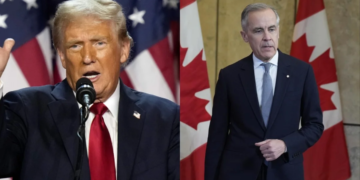In a dramatic April 2nd announcement, President Donald Trump declared sweeping new reciprocal tariffs – branding their April 6 tariff implementation as ‘Liberation Day’ for U.S. manufacturers. These measures, among the most aggressive in modern trade history, impose a 10% baseline tariff on all U.S. imports, with higher rates for key partners like China (34%), the EU (20%), and India (26%). The move has sent shockwaves through global markets, raising fears of economic upheaval and retaliatory actions. With additional increases scheduled for April 9, the policy signals a dramatic shift in America’s trade strategy—one that could redefine international commerce for years to come.
The April 6 Tariff Breakdown: Who Pays the Price?

Trump’s new policy targets what he calls “decades of unfair trade practices.” While Canada and Mexico remain exempt due to existing trade agreements, major economies face steep hikes designed to pressure them into renegotiating terms. The tiered structure reveals clear priorities:
- China bears the brunt at 34%, reflecting ongoing tensions over intellectual property and market access.
- India faces a 26% rate, disproportionately affecting its thriving pharmaceutical and gemstone exports.
- The EU confronts a 20% levy, threatening German automakers and French luxury goods.
- Japan (24%) and South Korea (25%) see targeted increases in electronics and automotive imports.
The administration argues these tariffs will revive U.S. manufacturing and slash the 1.1 trillion trade deficit. JPMorgan estimates the duties could inflate costs by a 1.1 trillion trade deficit.JPMorgan estimates the duties could inflate costs by 660 billion on $3.3 trillion of imports—equivalent to 2.2% of U.S. GDP. Fitch Ratings predicts the average U.S. tariff rate will skyrocket to 22%, a level unseen since the Smoot-Hawley tariffs of the 1930s.
Global Backlash and Economic Fallout
The announcement triggered immediate pushback from trading partners. Within hours of the declaration:
- China’s Commerce Ministry demanded an immediate reversal of the “unilateral 34% aggression,” hinting at countermeasures targeting U.S. agricultural exports.
- An urgent summit was called by EU chief Ursula von der Leyen.
- India’s Trade Ministry convened crisis talks with exporters, particularly in pharmaceuticals and jewelry, where tariff gaps exceed 10%.
Emerging markets face acute challenges. India’s diamond polishing industry—which processes 90% of the world’s gems—could see $12 billion in exports jeopardized by the 13.3% tariff gap. Meanwhile, Congress MP Renuka Chowdhury blasted the government’s ‘directionless’ approach, her voice cutting through the parliamentary chaos. ‘Where is the contingency plan?’ she demanded, as opposition benches erupted in agreement.
Will the April 6 Tariff Spark a Full-Blown Trade War?
The tariffs risk igniting a prolonged global trade conflict reminiscent of 2018-2019 skirmishes—but with higher stakes. Trump advisor Peter Navarro insists the pain will be temporary: “When BMW and TSMC build plants in Ohio instead of Leipzig or Taipei, Americans win.” Yet evidence suggests complications:
- Supply Chain Chaos: Apple’s Tim Cook reportedly lobbied against the tariffs, warning iPhone production costs could spike 19%.
- Consumer Impact: Walmart forecasts price hikes on electronics and apparel by Q3 2025.
- Retaliation Risks: China may restrict rare earth mineral exports, while the EU could target U.S. tech firms with digital taxes.
Markets have reacted with volatility. While India’s Sensex rebounded 1.2% on April 3 on blue-chip buying, the Shanghai Composite plunged 3.4%—its worst day since 2022. The U.S. Dollar Index surged 2.1% as investors fled to safety.
A New Era of Trade Uncertainty
The April 6 Tariff marks the most dramatic U.S. trade policy shift in a generation. Proponents hail it as long-overdue protection for American workers; critics see a recipe for stagflation and diplomatic fractures. As nations scramble to adapt through WTO appeals, domestic subsidies, or retaliatory measures, the world faces a critical question. Will force reshoring boost U.S. manufacturing as intended? Or, will the April 6 Tariff instead fragment global supply chains and accelerate deglobalization?
One outcome seems certain, these measures will dominate economic discourse through the 2024 election cycle and beyond, with consequences far exceeding Trump’s first-term trade wars.















Discussion about this post